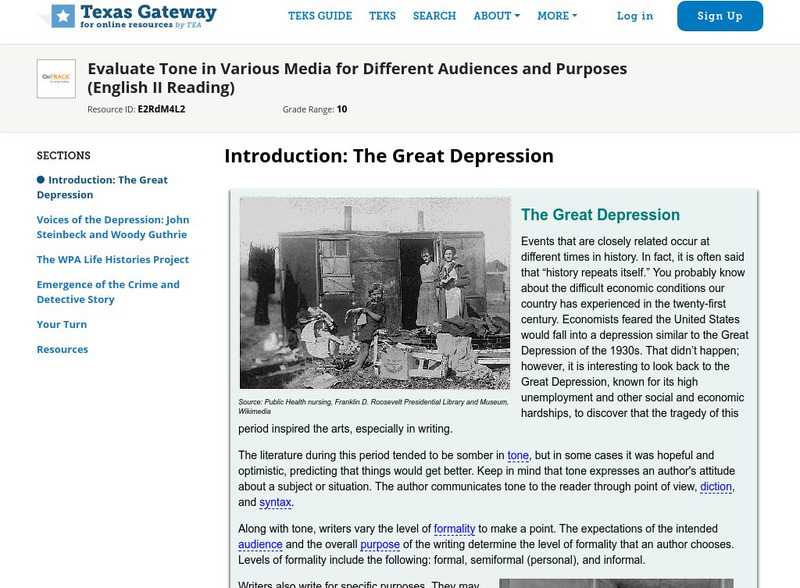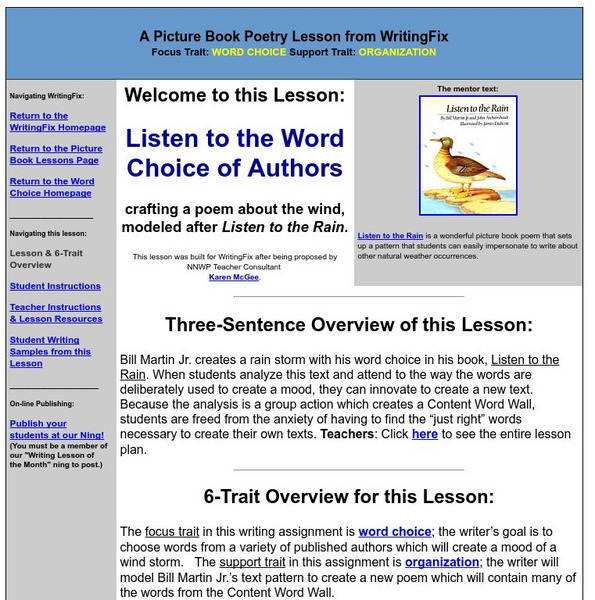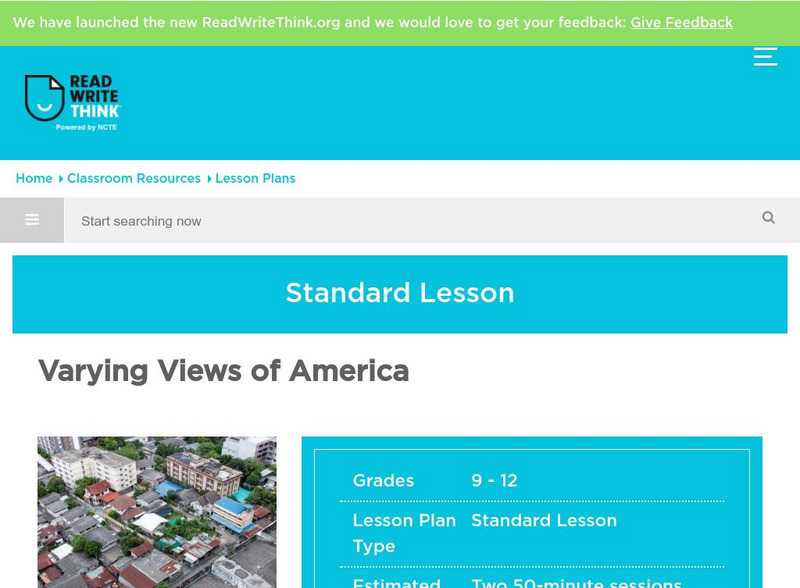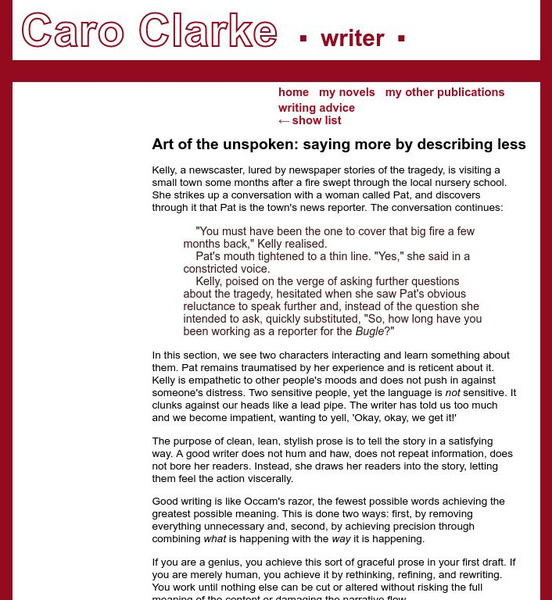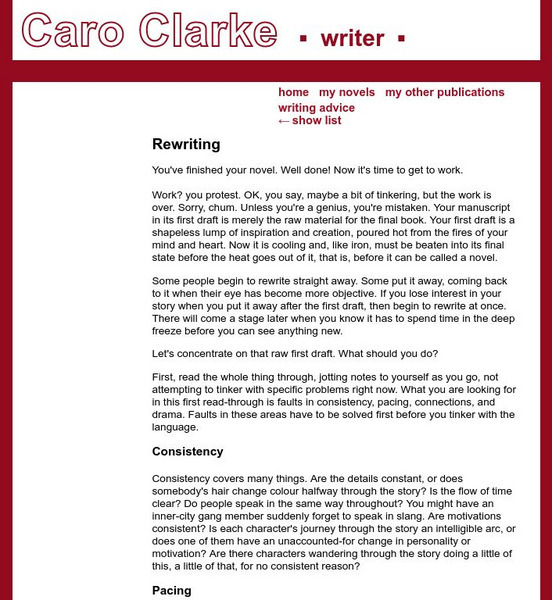Hi, what do you want to do?
Curated OER
Model Lesson Plans
Ninth graders study how to identify and analyze the use of figurative language used in selected poems, short stories or other pieces of prose chosen by the teacher. These pieces of literature represent at least two pieces by one writer...
Curated OER
Children's Media and Censorship
Students examine the point of censorship when dealing with Students. They explore essays by Stephen King.
Curated OER
Promoting the South Carolina Junior Book Award Nominees
Sixth graders recongize and analyze different components of a piece of literature. They must also practice their oral communcation skills by reading a book to an audience.
Curated OER
Silent Spring
Students read background information about Rachel Carson found on the listed website links. They analyze and answer questions about her work and how it is linked to science then they research pesticide usage and alternative methods.
Curated OER
Challenges in Changing the Face of a City
Students examine a video in which people want to change the city of Oakland, California. They decide on the best course of action.
Curated OER
Building A Literary Reference Card
Twelfth graders create a reference card for "The Adventures of Huckleberry Finn". They use both sides of the index card and share their responses with the class.
Curated OER
African-American History and Culture in the English Classroom
Ninth graders identify and recognize characteristics of nonfiction in literary works, explore language and culture of Gullah people, compare and contrast purposes of spirituals and quilts in terms of their relationships to escape from...
Better Lesson
Better Lesson: Finding the Author's Purpose
What is autism? How does it affect behavior? Students will find evidence of the author's tone or purpose for writing the article, as well as hints that show evidence of opinion. Includes a video clip from the movie "Rainman", and an...
Texas Education Agency
Texas Gateway: Diction and Tone (English Ii Reading)
This lesson will help students identify diction and tone in their reading and will help them answer these questions: What does the author mean? What is the author's attitude about what he or she is writing? How will my understanding of a...
Better Lesson
Better Lesson: Audience, Tone, and Style in Informative Text
Students will read samples of informative writing and highlight examples of how tone and style are used by the authors. Students will then apply this knowledge by writing their own informative text. Multiple examples of student work and...
Texas Education Agency
Texas Gateway: Evaluate Tone in Various Media for Different Audiences & Purposes
This lesson will help you evaluate changes in formality and tone within printed texts written for specific audiences and purposes. It focuses on writing produced during the Great Depression.
Texas Education Agency
Texas Gateway:diction and Tone (English I Reading)
In this learning module, the user will learn and apply the concepts of tone and diction. Tone is the author's attitude toward the writing. Tone is largely determined by diction or the words that an author chooses.
Writing Fix
Writing Fix: Mob's Voice vs. Hero's Voice
In this lesson, the novel To Kill a Mockingbird, written by Harper Lee, is used to get students to explore point of view and issues related voice in writing and social justice. This lesson requires the students to analyze and discuss the...
Writing Fix
Writing Fix: Listen to the Word Choice of Authors: Crafting a Poem
Students will analyze a poem's word choice and then create a poem of their own using word wall vocabulary.
ReadWriteThink
Read Write Think: Poetry: Varying Views of America
Lesson allows students to examine the various views of American perspective through studying three poems by diverse poets: "I Hear America Singing" by Walt Whitman, "I, Too, Sing America" by Langston Hughes, and "On the Pulse of Morning"...
British Library
British Library: 19th Century Non Fiction Texts: Crime & Punishment
This thematic collection will allow young scholars to read and understand 19th-century non-fiction texts, and support them in identifying key features for a range of genres, audiences, and purposes. Each source is accompanied by original...
British Library
British Library: 19th Century Non Fiction Texts: Work & Welfare
This thematic collection will allow students to read and understand 19th-century non-fiction texts, and support them in identifying key features for a range of genres, audiences, and purposes. Each source is accompanied by original...
British Library
British Library: 19th Century Non Fiction Texts: Gender, Behaviour & Etiquette
This thematic collection will allow learners to read and understand 19th-century non-fiction texts, and support them in identifying key features for a range of genres, audiences, and purposes. Each source is accompanied by original...
British Library
British Library: 19th Century Non Fiction Texts: Education
This thematic collection will allow students to read and understand 19th-century non-fiction texts, and support them in identifying key features for a range of genres, audiences, and purposes. Each source is accompanied by original...
Sophia Learning
Sophia: Punctuation and Style
A nine-slide presentation discussing how to use punctuation to create or reflect the author's style. W.9-10.1d Style/tone/conv
Caro Clarke
The Art of the Unspoken: Saying More by Describing Less
This is the thirteenth article in a series that was developed to help the new novel author. This article focuses on how good descriptions aren't necessarily connected with a lot of words, good descriptions are clean and to the point.
Caro Clarke
Rewriting
This is the 17th article in a series that helps the new fiction author with the final step--revision.
Sophia Learning
Sophia: Diction
This lesson introduces diction. This tutorial shares a short audio lesson [5:11] and supplemental notes with the lesson's content.
Scholastic
Scholastic: Johnny Tremain
Come and discover more about the novel, "Johnny Tremain," by Esther Forbes. This site features a discussion guide, writing prompt, vocabulary builder, extension activity and more.















